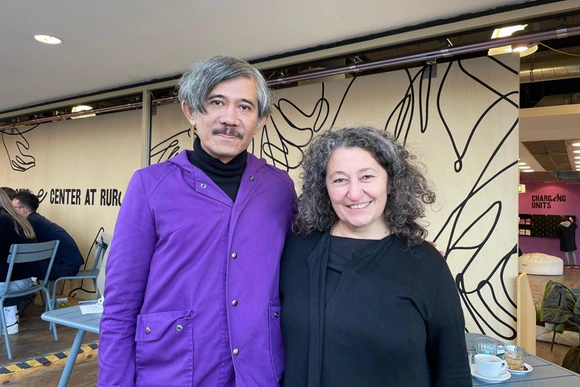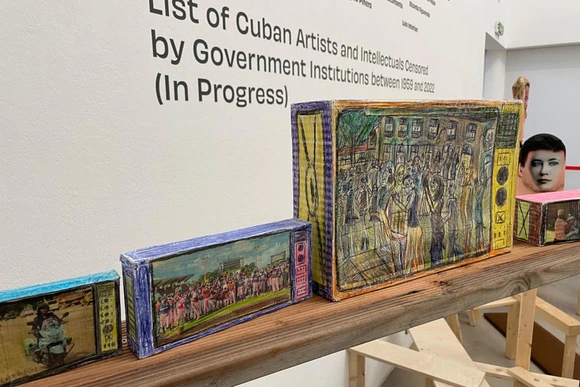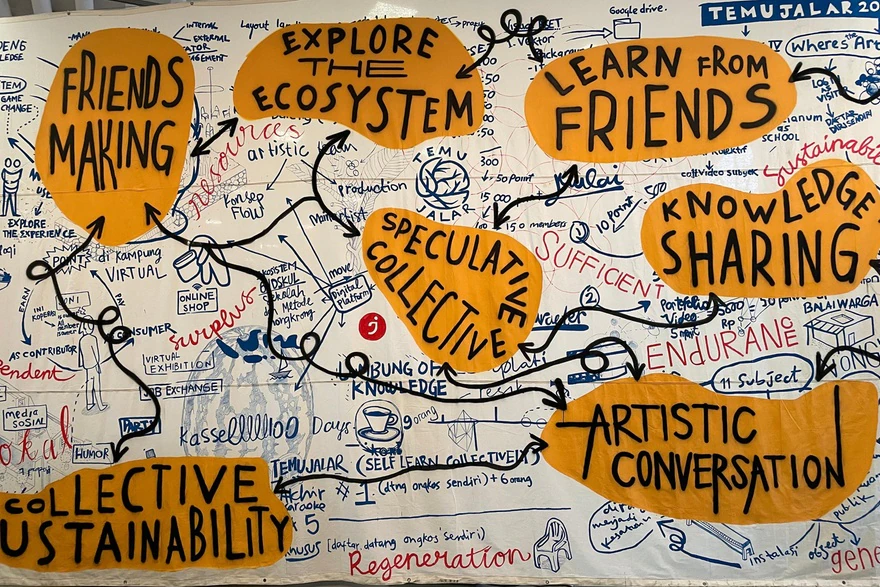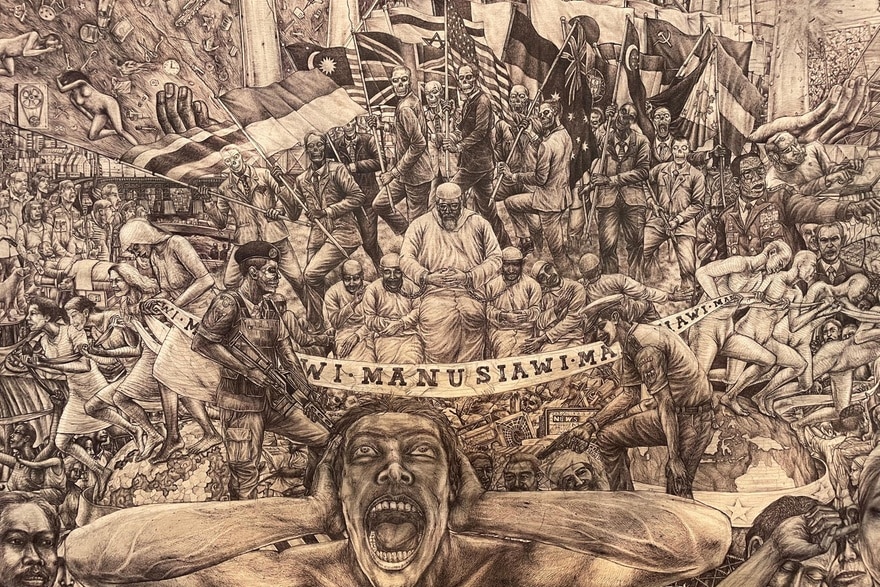The Indonesian group Taring Padi in the eye of the storm: their collaborative works are not afraid to use strong symbolic language. The use of antisemitic images, though, touched a very sensitive nerve in Germany. Eduardo Simantob/SW
A heated controversy over antisemitism overshadowed important issues raised by the ambitious contemporary art show that takes place every five years in Kassel, Germany. But the exhibition, that ended on September 25, will go down in history as a milestone in the North–South artistic divide. This content was published on September 28, 2022 – 09:00 September 28, 2022 – 09:00
documenta fifteenExternal link faced higher expectations than usual. It was the first time that a group – the Indonesian collective of artists and activists ruangrupaExternal link – was appointed to its artistic direction, instead of a “super curator”. But more significantly, it was also the first time that documenta was placed in non-Western hands.
Their appointment was politely welcomed as it ticked many politically correct boxes. However, the debate on antisemitic depictions (see box below) practically monopolised the local and international coverage of the show.
“It makes me very sad,” Indra Ameng, one of the members of ruangrupa, told SWI swissinfo.ch. “This whole discussion sidelined more promising discussions we wanted to raise, and we were thrown into a debate that wasn’t ours”

Ameng doesn’t mean that antisemitism is irrelevant for ruangrupa, but that it is an imported question. As the Swiss historians Bernhard Schär and Monique Ligtenberg explained in an articleExternal link about the long-lasting effects of colonialism and the Suharto dictatorship, “anti-Semitism in Indonesia is not a Javanese invention. It is the complex legacy of a colonial, including German, cultural export that contemporary Indonesians have appropriated and transformed.”
documenta fifteen already expected to come under fire for turning upside down the Western notions of what an art exhibition should be. For a start, artistic and politically active collectives took the fore, effacing individual artists. Western (i.e., European and North American) output was nowhere to be seen. Instead, the curatorial arc spanned the world’s ‘South’ (which used to be called ‘Third World’) and the work of minorities, such as the Roma but also refugees, the queer community, and neurominorities.
The German discomfort
A Swiss perspective
The Swiss participation in documenta fifteen was limited to one single member of a collective (among other 1,500 participants) and the support of the Swiss arts council Pro Helvetia. However, Swiss artists and curators played a fairly outsized role, relative to the size of the country, in the documenta history (see box at the end of this article).
Besides, ruangrupa’s approach is a call to awareness directed not just to the German public and institutions, but also to a whole European and ‘Western’ cultural edifice, built upon notions developed throughout centuries of colonial and imperialistic history in which Swiss mercenaries, enterpreneurs, and capital played a big role.
The choice of ruangrupa was seen as a new, fresh start. To the German institutions’ credit, it must be noted that never before has any relevant and deep-pocketed Western contemporary art show opened its space with free rein to those genuinely stemming from the Global South and not belonging to its ‘westernized’ elites, as was the case with documenta 11’s artistic director, the Nigerian Okwui Enwezor.
The West is no more the best
Concepts such as ‘post-colonial’ or ‘post-gender’, for example, are normal currency in Western cultural debate, institutions, and universities. In ruangrupa’s position, these terms acquire material reality in the daily plights of disenfranchised communities, and material solutions in self-empowered collectives.
The same can be said about the questions over the primacy of the artist and the fabrication of artistic ‘geniuses’. It is a stated fact even in the West that the age of big names like Picasso or Van Gogh is over, but the art schools keep throwing thousands of new artists in the market every year with the ambition to strike a great deal with a powerful gallery and make his or her or their names a staple of private or public collections.
ruangrupa, though, makes it clear that there would be no Asian Matisse or an African Beuys in their show. Instead, what we see is that even established artists, such as the Cuban Tania Bruguera, merrily effaced their individual names under the auspices of the collectives in which they take part (in Bruguera’s case, the Hannah Arendt International Institute of Artivism – INSTAR).

Lumbung is the word
“Lumbung” is documenta fifteen’s keyword. It is an Indonesian word for a “communal rice-barn, where the surplus harvest is stored for the benefit of the community”. ruangrupa extended the meaning to all kinds of collaborative work, going beyond the anarchist concept of “mutual aid”. In fact, this is a practice all over the world and sustained not just by art collectives or as an alternative fad of the so-called generation Z (the one reaching adulthood in the 2010s). Art here is just one of the tools, mixed in social projects and political activism, used by networked collectives.

documenta fifteen opened lots of windows into how people in impoverished societies do and think art. Contrary to the Western notion, where art has lost its spontaneity for the sake of technical prowess and is enclosed in its own technical realm (paraphrasing the critic Boris Groys), ruangrupa brings a world where art is undissociated from the popular culture and daily life. Where there are no public or private grants, generous foundations, or richly endowed art schools.
In these realities, the collective is not a matter of ideology but of sustainability and survival. The Turkish-German curator Ayse Gülec stresses that the whole documenta fifteen was made according to these principles. “Lumbung is not a metaphor here, we really worked based on its principles of collaboration and solidarity”, she says.
The artworks are deeply related to political, environmental, and social issues. But differently from the usual tone of denunciation in political art, these lumbung activists and artists are seriously (though not necessarily successfully) looking for solutions to the issues they raise.
This form of organization also affected more mundane and practical questions. Alexander Supartono, a member of the Taring Padi collective (the one at the center of the antisemitism debate), told SWI that the documenta administration didn’t know how to pay the artists, for example. After all, the collectives do not have bank accounts. “Punctuality is another prison”, he says, but despite these little glitches, the experience as a whole left definitive marks. “documenta made us much stronger”, he says, “we validated our ways of working, collaborating, and spreading solidarity.”
Visitors were certainly challenged by a grand exhibition that in many instances looks like naïve works of art students. At certain points the show sounds indeed a bit flat, lacking the depths with which contemporary art is usually associated. Or even too reliant in rhizomic diagrams that confound more than illuminate the works on display. But still, it showed that another way of looking at and working on the world is possible – and necessary.



